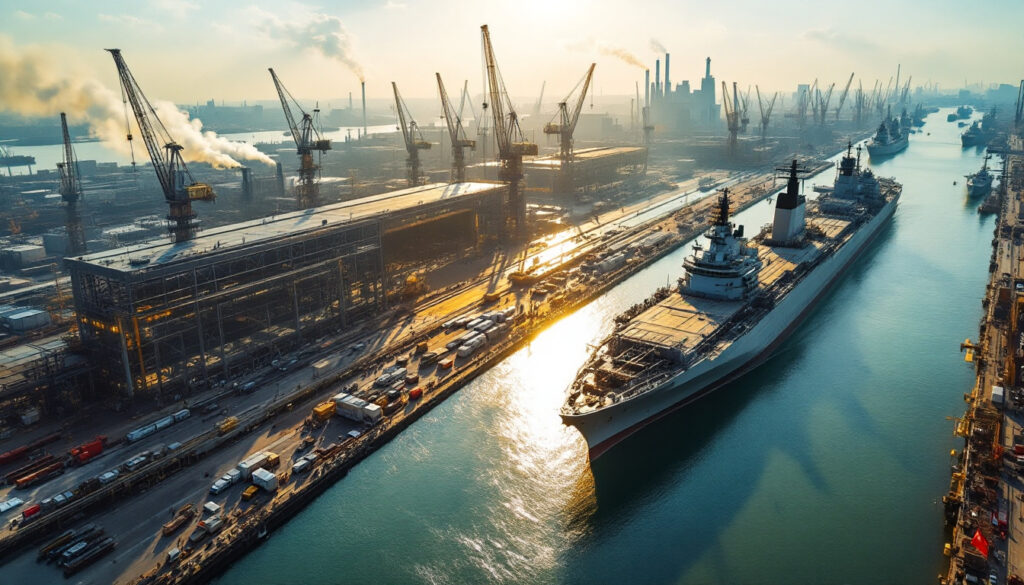How Has China Dominated the Global Shipbuilding Industry?
China's shipbuilding sector has achieved remarkable dominance in the global market, maintaining leadership across all key industry indicators for 15 consecutive years. This unprecedented success reflects a combination of strategic economic planning, cost advantages, and an integrated manufacturing ecosystem that competitors have struggled to match.
The Chinese shipbuilding industry's rise represents one of the most successful examples of industrial policy implementation in modern history. By leveraging its manufacturing capabilities, labor advantages, and material resources, China has transformed what was once a fragmented domestic sector into the world's maritime construction powerhouse.
According to the Ministry of Industry and Information Technology (MIIT), Chinese shipyards now command 55.7% of global shipbuilding completion volume, secure 74.1% of worldwide new orders, and hold 63.1% of the total global order book. These figures reflect not just momentary success but sustained competitive advantage in an industry traditionally dominated by European, Japanese, and South Korean builders.
What Makes China the World's Shipbuilding Powerhouse?
Market Dominance Through Key Performance Indicators
China's shipbuilding industry has systematically captured market share through a comprehensive approach to manufacturing efficiency. The country's shipyards have optimized production techniques that combine traditional craftsmanship with cutting-edge automation, creating a hybrid model that maximizes both quality and output.
The MIIT data shows China's commanding position across all three critical industry metrics—completions, new orders, and backlog—creating a virtuous cycle where current production excellence fuels future order growth. This positive feedback loop has allowed Chinese shipyards to invest in capacity expansion while competitors struggle to maintain existing facilities.
Competitive Cost Structure
The foundation of China's shipbuilding success lies in its significant cost advantages:
Labor cost efficiency remains substantial despite rising wages in coastal regions. Chinese shipyards have implemented tiered labor structures where highly skilled workers focus on critical tasks while apprentice programs develop specialized talent at lower wage scales.
Supply chain integration creates exceptional efficiencies through proximity. Unlike competitors who often import components from distant suppliers, Chinese shipbuilders benefit from manufacturing clusters where critical components are produced within the same industrial zones as the shipyards themselves.
Material sourcing advantages provide significant cost benefits, particularly in steel procurement. With China producing over half the world's steel, shipbuilders enjoy both price advantages and priority allocation during supply constraints.
Price Comparison with International Competitors
The cost differential between Chinese and Western shipbuilders is remarkable and represents the primary driver of market share shifts:
A standard container vessel built in China costs approximately $60 million, while an equivalent ship constructed in American yards would cost around $330 million. This dramatic 82% cost advantage makes Chinese shipyards the default choice for most international shipping companies seeking fleet expansion or replacement vessels.
Even compared to other Asian competitors, Chinese yards maintain a 15-30% cost advantage while achieving comparable quality standards. This combination of competitive pricing and acceptable quality has proven irresistible to commercial operators focused on return on investment.
Why Are Chinese Shipyards Resilient Against Trade Barriers?
Strong Order Books Provide Long-Term Security
Chinese shipbuilders have demonstrated exceptional resilience in the face of international trade tensions and potential barriers. This durability stems from several structural advantages:
The order books extending to 2028 provide a multi-year production runway that insulates shipyards from short-term market fluctuations or policy changes. With nearly 75% of global new orders, Chinese yards can weather significant disruptions while maintaining production schedules.
Customer diversification across Europe, Asia, Middle East, and Latin America ensures that potential bilateral trade restrictions with any single country or region would have limited impact on overall operations. This global client base represents a strategic hedge against protectionist policies.
Limited Impact of US Port Fee Proposals
Recent American proposals for special port fees targeting Chinese vessels have been significantly scaled back from initial announcements:
Exemptions for smaller vessels under 10,000 deadweight tonnage protect a significant segment of the shipping market from additional costs. This carve-out reflects the practical reality that alternative construction capacity doesn't exist for many specialized vessel types.
Bulk carriers transporting essential commodities like coal and grain received exemptions to avoid disrupting critical supply chains and potentially increasing consumer costs. This pragmatic approach acknowledges the interdependence of global trade systems.
Service fee caps limiting charges to $1.5 million for Chinese-built vessels and $1 million for Chinese-owned operators represent a substantial reduction from earlier proposals that could have imposed percentage-based fees on total vessel value.
Recent Trade Tension De-escalation
Market indicators suggest a potential easing of trade pressures:
Recent statements indicating final tariffs "won't be anywhere near 145%" signal a shift toward moderation in trade policy. This apparent de-escalation reflects recognition of the mutual dependencies within global shipping markets.
References to "setting the stage for a deal with China" suggest a pathway toward negotiated solutions rather than unilateral actions. This diplomatic opening creates space for industry adaptation and compliance planning.
Steel futures markets responded positively to these signals, with Shanghai rebar futures rising 3.2% following clarifications about the scope and scale of potential restrictions. This market reaction indicates investor confidence in the resilience of China's maritime manufacturing sector.
How Does Shipbuilding Drive China's Steel Industry?
Specialized Steel Production Growth
The shipbuilding industry has become a crucial driver for China's steel sector, particularly for high-grade, specialized products:
The first quarter of 2025 saw a 28.9% year-over-year increase in shipbuilding steel plate production, reaching 5.02 million tonnes among 36 major Chinese steelmakers tracked by the China Iron & Steel Association (CISA). This growth contrasts sharply with the broader steel market, which experienced only modest expansion.
Steel represents 20-30% of total shipbuilding costs, making it the single most significant material input in vessel construction. This substantial proportion means that shipbuilding demand has become a key indicator for specialized steel producers, influencing capacity planning and investment decisions.
Premium Pricing for Shipbuilding Steel
The specialized nature of marine-grade steel creates significant value-added opportunities:
Current shipbuilding steel plate prices range from 3,400-3,420 yuan ($466-469) per tonne in eastern China, commanding a premium of 195 yuan per tonne over standard hot-rolled coil products. This pricing advantage reflects the technical specifications required for marine applications, including corrosion resistance and structural integrity.
The premium has expanded dramatically from only 35 yuan three months earlier, demonstrating the strengthening demand for specialized marine steels even as general construction-grade steel faces pricing pressures. This divergence highlights the value of specialized production capabilities.
Market Resilience Against Broader Steel Industry Challenges
Shipbuilding-grade steel has maintained robust demand despite several headwinds affecting the broader steel market:
The overall steel sector has faced subdued domestic demand due to property market corrections and infrastructure spending moderation. However, shipbuilding steel has bucked this trend due to the export-oriented nature of vessel construction.
International trade defense measures targeting general Chinese steel exports have proliferated, but specialized marine grades often receive exemptions due to limited alternative supply sources and their critical role in global shipping infrastructure.
Regulatory scrutiny over non-VAT cargo exports has increased, but legitimate shipbuilding export channels remain open due to their documented end-use and value-added characteristics. This regulatory differentiation benefits specialized producers.
What Role Do Critical Materials Play in China's Shipbuilding Success?
Tungsten Demand Drives Raw Material Markets
Beyond steel, specialized materials like tungsten play a crucial but often overlooked role in shipbuilding capabilities:
Tungsten is essential for producing wear-resistant parts and high-performance cutting tools used in precision manufacturing of propulsion systems and structural components. The material's unique properties allow for exceptional durability in marine environments.
As a critical component in specialized machinery and marine engineering applications, tungsten demand from the shipbuilding sector helps stabilize the entire rare metals supply chain. This sustained industrial demand complements China's critical mineral export restrictions that prioritize domestic manufacturing.
Strategic Material Supply Control
China's dominance in critical materials provides additional competitive advantages:
Current tungsten concentrate prices range from 145,500-150,000 yuan per tonne, reflecting strong industrial demand despite global economic uncertainties. China maintains strict output controls on tungsten to ensure sustainable resource utilization and price stability.
Export controls implemented since February 2025 prioritize domestic industrial users, including shipbuilding equipment manufacturers. This strategic approach ensures Chinese shipyards maintain uninterrupted access to critical materials while international competitors may face supply constraints or price volatility.
The integration of materials production and manufacturing represents a significant advantage that competitors in Korea, Japan, and Europe cannot easily replicate due to their limited domestic resources of critical minerals.
Next-Generation Vessel Requirements
Evolving vessel designs are increasing the importance of specialized materials:
Modern shipbuilding increasingly emphasizes durability and performance to meet stricter environmental and operational requirements. This shift has elevated the importance of specialized alloys and composite materials in vessel construction.
Material selection priorities now extend beyond initial construction cost to include life-cycle performance, maintenance requirements, and eventual recyclability. This holistic approach favors sophisticated material systems where China has developed comprehensive capabilities.
What Factors Will Shape the Future of Chinese Shipbuilding?
Technological Advancement and Innovation
China's shipbuilding industry is rapidly evolving beyond cost advantages to establish technological leadership:
Substantial investments in next-generation vessel designs focus on autonomous navigation systems, advanced propulsion technologies, and digital twin modeling for predictive maintenance. These innovations create new competitive advantages beyond traditional cost factors.
Fuel efficiency and environmental compliance have become central design priorities as international regulations tighten emission standards. Chinese yards have pioneered dual-fuel engines, hull optimization, and exhaust treatment systems to meet these requirements.
Development of specialized vessels for emerging industries such as offshore renewable energy, deep-sea mining, and polar exploration represents a strategic pivot toward higher-value market segments. These specialized vessels command premium prices while requiring advanced technical capabilities.
Supply Chain Integration
Vertical coordination across the maritime manufacturing ecosystem enhances China's competitive position:
The integration between material production and manufacturing creates efficiencies impossible to achieve in fragmented supply chains. Chinese shipyards often maintain equity stakes in key component suppliers, ensuring priority allocation during high-demand periods.
Enhanced coordination between steel producers and shipyards allows for just-in-time delivery of custom plate specifications, reducing inventory costs and improving production scheduling. This synchronized approach minimizes capital requirements while maximizing throughput.
Domestic sourcing of critical components and materials reduces exposure to international supply chain disruptions and currency fluctuations. This self-sufficiency provides operational stability during geopolitical uncertainties that can disrupt international competitors.
International Trade Dynamics
Navigating shifting trade relationships remains a strategic priority:
Ongoing adaptation to trade tensions and potential tariffs involves sophisticated contract structures that distribute risk between builders, operators, and financing entities. This flexible approach allows projects to proceed despite uncertain policy environments.
The potential for negotiated agreements with major markets creates pathways for continued market access, particularly for specialized vessel types where alternative construction capacity is limited. These diplomatic solutions recognize mutual dependencies in global shipping.
Diversification of customer base beyond traditional markets reduces dependency on any single region or trade relationship. This global approach spreads political risk while expanding market opportunities in emerging economies with effective geopolitical market strategies.
How Does China's Shipbuilding Industry Impact Global Markets?
Effects on Raw Material Supply Chains
China's shipbuilding dominance creates ripple effects throughout global commodity markets:
Sustained demand for steel and specialty metals from shipbuilding provides baseline consumption that supports producer investments in capacity maintenance and quality improvements. This predictable demand reduces market volatility and contributes to the emerging commodity super cycle.
Price support for tungsten and other critical materials benefits miners and processors worldwide, despite geopolitical tensions over strategic resource control. The industrial demand from shipbuilding creates market stability that benefits the entire supply chain.
Global commodity trading patterns increasingly reflect Chinese shipbuilding requirements, with specialized grades and specifications becoming standardized around Chinese yard preferences. This influence extends beyond direct suppliers to shape broader material markets.
Competitive Pressure on International Shipbuilders
The Chinese shipbuilding industry has fundamentally reshaped the global competitive landscape:
Price advantages have forced efficiency improvements at international yards, particularly in Korea and Japan, where automation, design standardization, and labor reforms have accelerated in response to Chinese competition. This productivity race benefits the entire industry.
Market share consolidation among Chinese yards has created economies of scale unmatched elsewhere, particularly in standard vessel categories like container ships and bulk carriers. This concentration allows for continued investment in capacity expansion while competitors rationalize operations.
Specialization requirements have pushed non-Chinese competitors toward higher-value niches such as cruise ships, military vessels, and advanced offshore installations. This market segmentation reflects realistic adaptation to comparative advantages.
Maritime Transport Economics
The shipbuilding industry directly impacts global shipping costs and capacity:
Lower vessel construction costs potentially reduce long-term shipping rates by decreasing the capital recovery component of voyage economics. This cost reduction ultimately benefits global trade through more efficient transportation infrastructure.
Increased global fleet capacity through Chinese production helps match shipping availability to growing trade volumes, preventing capacity constraints that could otherwise create inflationary bottlenecks in supply chains. This expansion supports global economic growth.
Accelerated replacement of older, less efficient vessels improves fleet emissions performance and operating economics simultaneously. This renewal cycle, driven by Chinese construction efficiency, yields both environmental and commercial benefits that influence global commodities market insights.
FAQ: Understanding China's Shipbuilding Industry
What percentage of global shipbuilding does China control?
China accounts for 55.7% of global shipbuilding completion volume, 74.1% of new orders worldwide, and 63.1% of total orders on hand as of 2024, according to China's Ministry of Industry and Information Technology. This dominance spans all major market segments including container ships, bulk carriers, and increasingly, liquefied natural gas (LNG) carriers.
How much cheaper are Chinese-built ships compared to US alternatives?
A Chinese-built container ship costs approximately $60 million, while an equivalent vessel built in the US costs around $330 million—representing an 82% cost advantage for Chinese shipbuilders. This dramatic differential reflects differences in labor costs, material sourcing, regulatory requirements, and production scale efficiencies.
What materials are critical to China's shipbuilding industry?
Steel plates represent 20-30% of shipbuilding costs, while specialty materials like tungsten are essential for producing wear-resistant parts and cutting tools used in ship construction. China's domestic control of these material supply chains creates significant competitive advantages through assured access and predictable pricing.
How far into the future do Chinese shipyards have orders secured?
Chinese shipyards have secured orders extending as far as 2028, providing long-term stability and resilience against short-term market fluctuations or trade barriers. This extended production visibility allows for confident capital investment planning and workforce development despite geopolitical uncertainties.
What impact will US port fees have on China's shipbuilding industry?
The scaled-back US port fee proposal is expected to have minimal impact on China's shipbuilding industry due to exemptions for certain vessel types, the strong existing order book, and the global diversification of Chinese shipyards' customer base. The modified policy approach reflects practical recognition of limited alternative construction capacity and potential China stimulus impact on markets.
Further Exploration:
Readers interested in learning more about global shipbuilding trends and maritime economics can explore related educational content available through industry publications and market analysis reports focused on international shipping and maritime construction.
Want to Capitalise on the Next Major Mineral Discovery?
Receive instant alerts when significant ASX mineral discoveries are announced with Discovery Alert's proprietary Discovery IQ model, transforming complex mineral data into actionable trading opportunities. Learn why historic discoveries can generate substantial returns by visiting Discovery Alert's dedicated discoveries page and begin your 30-day free trial today.




